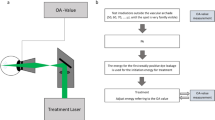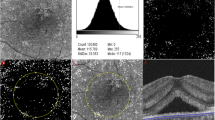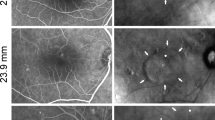Abstract
Purpose
To study the regression patterns of subretinal fluid (SRF) in central serous chorioretinopathy (CSCR) on sequential en face optical coherence tomography (OCT) and its relationship to leak locations.
Methods
Retrospective study on patients with acute CSCR. Inclusion criteria were (i) availability of data, sequential OCT and OCT angiography (B scan and en face OCT) every 2 weeks until resolution of SRF or 6 months, whichever is earlier; (ii) single active leak. Exclusion criteria were (i) presence of macular neovascularization or atypical CSCR, (ii) diffuse pigment epitheliopathy, (iii) multiple leaks. Serial en face OCT scans were evaluated and the area of SRF was measured using ImageJ software. Correlation coefficient was calculated for the regression rate of SRF area and central retinal thickness (CRT) over the first month of follow-up and the time of complete SRF resolution.
Results
Out of the 25 eyes, 20 eyes demonstrated a centripetal regression, and 5 eyes demonstrated a centrifugal regression. In eyes with a leakage point <1000μ from the fovea, 86% resolved in a centripetal fashion, and in eyes with leak site ≥1000μ away from fovea, 70% eyes resolved centripetally. There was a correlation (r=−0.47, p=0.018) of the rate regression of SRF area during the first month and timing of resolution. In contrast, this correlation was absent (r=−0.16, p=0.44) for CRT regression.
Conclusion
Our en face–based analysis of sequential OCTs of regressing CSCR demonstrated a tendency for the subfoveal SRF to resolve towards the end or a centripetal pattern of regression. Prediction of resolution of SRF at 1 month is better with en face area of SRF in comparison to CRT.




Similar content being viewed by others
Data availability
Available upon request.
Code availability
Not applicable.
References
van Rijssen TJ, van Dijk EHC, Yzer S et al (2019) Central serous chorioretinopathy: towards an evidence-based treatment guideline. Prog Retin Eye Res 73:100770. https://doi.org/10.1016/j.preteyeres.2019.07.003
Klein ML, Van Buskirk EM, Friedman E, Gragoudas E, Chandra S (1974) Experience with nontreatment of central serous choroidopathy. Arch Ophthalmol 91(4):247–250. https://doi.org/10.1001/archopht.1974.03900060257001
Daruich A, Matet A, Marchionno L et al (2017) Acute central serous chorioretinopathy: factors influencing episode duration. Retina 37(10):1905–1915. https://doi.org/10.1097/iae.0000000000001443
Schneider CA, Rasband WS, Eliceiri KW (2012) NIH Image to ImageJ: 25 years of image analysis. Nat Methods 9(7):671–675. https://doi.org/10.1038/nmeth.2089
Mohammad F, Wanek J, Zelkha R, Lim JI, Chen J, Shahidi M (2014) A method for en face OCT imaging of subretinal fluid in age-related macular degeneration. J Ophthalmol 2014:720243. https://doi.org/10.1155/2014/720243
Arf S, Hocaoglu M, Sayman Muslubas I, Karacorlu M (2017) Efficacy of reduced-fluence photodynamic therapy for central serous chorioretinopathy associated with combined serous retinal detachment and fovea-involving pigment epithelial detachment. Int Ophthalmol 37(3):483–489. https://doi.org/10.1007/s10792-016-0286-4
Lotery A, Sivaprasad S, O'Connell A et al (2020) Eplerenone for chronic central serous chorioretinopathy in patients with active, previously untreated disease for more than 4 months (VICI): a randomised, double-blind, placebo-controlled trial. Lancet 395(10220):294–303. https://doi.org/10.1016/s0140-6736(19)32981-2
Shin YI, Kim KM, Lee MW, Kim JY, Jo YJ (2020) Long-term results of focal laser photocoagulation and photodynamic therapy for the treatment of central serous chorioretinopathy. Jpn J Ophthalmol 64(1):28–36. https://doi.org/10.1007/s10384-019-00697-0
Marmor MF (1990) Control of subretinal fluid: experimental and clinical studies. Eye (Lond) 4(Pt 2):340–344. https://doi.org/10.1038/eye.1990.46
Sahoo NK, Maltsev DS, Goud A, Kulikov AN, Chhablani J (2019) Choroidal changes at the leakage site in acute central serous chorioretinopathy. Semin Ophthalmol 34(5):380–385. https://doi.org/10.1080/08820538.2019.1635171
Singh SR, Invernizzi A, Rasheed MA, et al. (2020). Wide-field choroidal vascular analysis in central serous chorioretinopathy. Eur J Ophthalmol:1120672120963456. https://doi.org/10.1177/1120672120963456
Arora S, Maltsev DS, Sahoo NK et al (2021) Visual acuity correlates with multimodal imaging-based categories of central serous chorioretinopathy. Eye (Lond). https://doi.org/10.1038/s41433-021-01788-4
Mrejen S, Balaratnasingam C, Kaden TR et al (2019) Long-term visual outcomes and causes of vision loss in chronic central serous chorioretinopathy. Ophthalmology 126(4):576–588. https://doi.org/10.1016/j.ophtha.2018.12.048
Central Serous Chorioretinopathy Study Group:
Supriya Arora (Eye Care Center, Princess Margaret Hospital, Nassau NP, Bahamas); Brian Rosario (UPMC Eye Center, University of Pittsburgh, Pittsburgh); Abdul Rasheed Mohammed (School of Optometry and Vision Science, University of Waterloo, Canada); Oliver Beale (UPMC Eye Center, University of Pittsburgh, Pittsburgh); Sumit Randhir Singh (Nilima Sinha Medical College & Hospital, Rampur, Madhepura, Bihar 852113, India); Amrish Selvam (UPMC Eye Center, University of Pittsburgh, Pittsburgh); Gunjan Chhablani (Department of Computer Science, BITS Pilani, Birla Goa Campus, Goa, India); Ramesh Venkatesh (Department of Retina and Vitreous, Narayana Nethralaya, Bengaluru, India); Nikitha Reddy (Department of Retina and Vitreous, Narayana Nethralaya, Bengaluru, India); Alexei N. Kulikov (Department of Ophthalmology, Military Medical Academy, St. Petersburg, Russian Federation); Dmitrii S. Maltsev (Department of Ophthalmology, Military Medical Academy, St. Petersburg, Russian Federation)
Jay Chhablani (UPMC Eye Center, University of Pittsburgh, Pittsburgh)
Author information
Authors and Affiliations
Consortia
Corresponding author
Ethics declarations
Ethics approval
The study adhered to the tenets of the Declaration of Helsinki and ethical clearance was obtained by the institutional review board (University of Pittsburgh, Pittsburgh, USA; Independent Ethics Committee of Military Medical Academy, Russia; Narayana Nethralaya Eye Hospital, Bangalore, India, and Hyderabad Research Foundation, Hyderabad, India).
Consent to participate
Informed consent was obtained from all individual participants included in the study.
Consent for publication
Patients signed informed consent regarding publishing their data and photographs.
Conflict of interest
Dr Jay Chhablani is a consultant for Allergan, Salutaris MD, Novartis, and Biogen. The remaining authors have no proprietary or financial interest in any aspect of this report. No conflict of interest.
Additional information
Publisher’s note
Springer Nature remains neutral with regard to jurisdictional claims in published maps and institutional affiliations.
Rights and permissions
About this article
Cite this article
Arora, S., Rosario, B., Mohammed, A.R. et al. Regression patterns of central serous chorioretinopathy using en face optical coherence tomography. Graefes Arch Clin Exp Ophthalmol 260, 2475–2481 (2022). https://doi.org/10.1007/s00417-022-05636-3
Received:
Revised:
Accepted:
Published:
Issue Date:
DOI: https://doi.org/10.1007/s00417-022-05636-3




